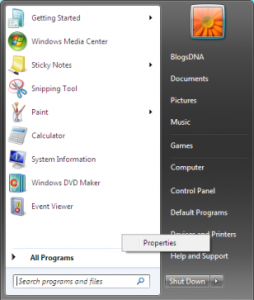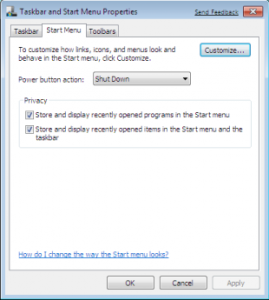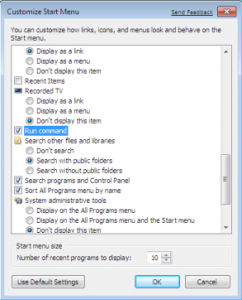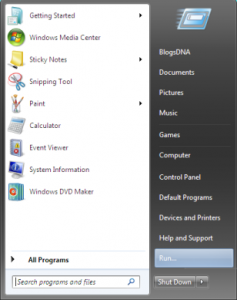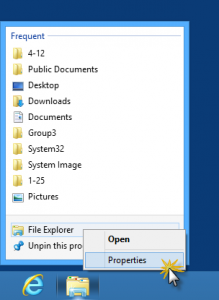In command line of Acad, type mbuttonpen, then enter. Set the value to 1. it will enable the pan/zoom function by using the wheel butoon
Category Archives: Tips
How to List Directories
tree /A [“directory path”] > c:\tree.txt
How to work with a merged cell
Select the merged cell >Format Cells>Alignment>Center across selection
and change the orintation as desirable, then copy/paste
How to Enable Run Command in Windows 7
How to Enable Run Command in Windows 7 Start Menu
1. Right Click on Windows 7 Start Menu and select Properties
2. Click on Customize under Start Menu tab
3. Scroll down and locate Run Command checkbox
4. Check “Run Command” option to enable Run command in your Start Menu, click Ok and Apply and save settings.
That’s it, Now check your start menu and you should see Run Command
Font too small to read in Outlook when composing emails
Font too small to read in Outlook when composing emails
In Outlook 2010, click the Zoom button in the ribbon and click “100%”
How to Enter a Line Break Within a Cell
How to Enter a Line Break Within a Cell
Solution:
You can control the line breaks for multiple-line headings or labels in your Microsoft Excel worksheet, just like you do in Microsoft Word. Here’s how to do it.
1.Click the cell where you want the label or heading to appear.
2.Type the first line of information.
3.Press ALT+ENTER.
4.Type the second line. Then repeat step 3 if you have additional lines to enter.
5.Press ENTER when you’ve finished typing.
Comment Off
Find the following line:
and delete it. THat’s simple at that!
Turn Adaptive Brightness On
To Turn Adaptive Brightness On or Off in Power Options
1. Open the Advanced Power Settings for your power plan.
2. Expand Display and Enable display brightness, then set adaptive brightness to be turned on or off for when your computer is On battery and Plugged in. (see screenshot below)
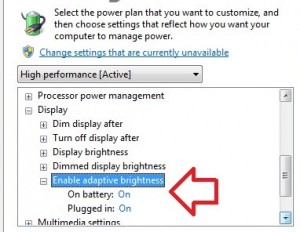
3. When finished, click on OK, and close the Power Options window.
Open Windows Explorer with Computer view
Open with Computer view
To begin, right click on the File Explorer icon on the taskbar to bring up the Jump List. Then, right click on the File Explorer command towards the bottom of the list and select the Properties command from the context menu. This process is illustrated in Figure B.
When you Jump List appears, right click on the File Explorer command and select Properties.
When you see the Properties dialog box, select the text in the Target text box, as shown in Figure C. Then, replace it with this command line:
%windir%\explorer.exe ::{20D04FE0-3AEA-1069-A2D8-08002B30309D}To complete the operation, just click OK.
Shortcut Keys
WINKEY – Open/close the Start Screen.
WINKEY + C – Open the Charms menu, which gives you options for Search, Share, Start, Devices, and Settings.
WINKEY + D – Switch to the classic Windows Desktop.
WINKEY + F – Search for Files via the Search charm.
WINKEY + I – Opens the Settings pane, which gives you current app settings, along with options for Network, Volume, Brightness, Notifications, Power, and the ability to change more PC settings.
WINKEY + L – Locks your PC and returns you to the lock screen.
WINKEY + O – Changes screen orientation (portrait/landscape) for tablet/slate PCs.
WINKEY + P – Opens the Second Screen panel so that you can choose how content on a projector or additional screen is displayed.
WINKEY + Q – Search within Apps via the Search charm.
WINKEY + Z – Opens the App Bar in a Windows Store app.
Also, when at the Start Screen, you can start searching for apps and programs just by typing. When searching, you can always change your search context (Apps, Files, Settings, search within apps) by clicking or tapping on the name of the item on the right-hand side.
Bypass login in windows 8
1. Boot your PC and enter your password.
2. Press Win-X.
3. In the pop-up menu that appears, click Command Prompt (Admin).
4. In the command prompt, type control userpasswords2, then press Enter.
5. In the User Accounts dialog that appears, uncheck the box marked Users must enter a user name and password to use this computer.
6. Click OK, then confirm the automatic sign-in option by entering your password (twice).
7. Reboot.
